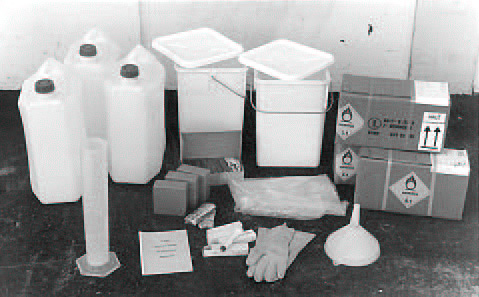KIT, CHLORINATION & WATER CONTROL (10,000 persons/1 week)
Valid Article
KIT, CHLORINATION & WATER CONTROL (10,000 persons/1 week)
Definition
Kit intended for the disinfection of drinking water. Can also be used for preparation of chlorine solutions.
Indications
KIT
The kit contains:
- Enough chlorine generating product (NaDCC) to disinfect at least 1.400 m³ of water (= 10,000 persons during one week [20 litres/person/day], or 500 families during one month). For more details see the relevant technical sheet in the Logistic Catalogue, "CWAT / Water and sanitation"
- Personal Protective Equipment for the operator
- equipment to test some water quality parameters before and after disinfection (turbidity tube and pool tester for the pH and the free residual chlorine concentration)
- dosing equipment (chlorine jar test)
Packaging
The chlorine generating product (NaDCC) is packaged separately and included in a "RTR" (regulated transport) module.
The available chlorine percentage should be mentioned on the packaging.
Instructions for use
Always check the turbidity before chlorinating water. Ideally the turbidity of water to be chlorinated has to be <5 NTU. Water with a turbidity up to 20 NTU is acceptable in acute emergencies.
Conduct regular supervision visits at all water distribution points and monitor the residual chlorine.
Remark
The taste and/or odour of chlorine are not proof of the presence of free residual chlorine in the water.
Disinfection of drinking water
To chlorinate drinking water, a stock ("mother") solution of 1% available chlorine is used.
The stock is prepared by adding one measuring spoon (included in the kit) of NaDCC into 1 litre of water.
The stock solution should be kept in an airtight, opaque, non metallic container, away from light and heat. It should be replaced every week.
For more detailed information and instructions see also "Public Health Engineering in Precarious Situations", MSF, 2nd edition, 2010:
- T.B. 2.13 Turbidity measurement
- T.B. 2.19 Chlorine-generating products
- T.B. 2.20 Preparation and use of chlorine solutions for disinfection
- T.B. 2.21 Batch chlorination of drinking water
- T.B. 2.22 Monitoring chlorination
- T.B. 2.23 Controlled bucket chlorination
Precautions for Use
- Staff responsible for chlorination and preparation of chlorine solutions have to be properly trained.
- NaDCC is a dangerous product: wear the protective apron, goggles and gloves supplied in the kit when preparing concentrated solutions
- Avoid inhaling vapour and dust when handling chlorine
- Do not expose to a naked flame, do not incinerate
- NaDCC should never be mixed with other chlorine generating products (f.e. NaDCC).
- Do not mix chlorine solutions with detergents (except in the case of anionic detergents as soft soap) and with acid solutions (ex: urine) since toxic gas could be released
- When exposed, accidentally or during storage, to concentrated chlorine fumes, or for repackaging large quantities of chlorine generating products, it is essential that the staff is properly protected (see "MODULE, PPE, for chlorine exposure" in the list of related articles below)
Transport Dangerous Goods
Storage
- Store in a dry, cool and well ventilated place. Be sure that the containers are well sealed after use.
- Store separately from food and beverages
- Keep out of the reach of children
- Good preservation (loss: 2 to 5% available chlorine per year)


![[CWATDISING1] CHLORINE NaDCC, 1kg, granules, pot](/web/image/product.template/547369/image_256/%5BCWATDISING1%5D%20CHLORINE%20NaDCC%2C%201kg%2C%20granules%2C%20pot?unique=5d94d04)
![[KWATMCHL01A] (module chlorination and water control) STANDARD ITEMS](/web/image/product.template/552013/image_256/%5BKWATMCHL01A%5D%20%28module%20chlorination%20and%20water%20control%29%20STANDARD%20ITEMS?unique=23e8a92)
![[KMEDKCHO1--] KIT, 001, 625 treatments, COMPLETE (LOG. + MED.) 4 000 L](/web/image/product.template/571201/image_256/%5BKMEDKCHO1--%5D%20KIT%2C%20001%2C%20625%20treatments%2C%20COMPLETE%20%28LOG.%20%2B%20MED.%29%204%20000%20L?unique=ceab957)
![[KWATKTRE10-] KIT, WATER TREATMENT UNIT, 10 m³/h](/web/image/product.template/552004/image_256/%5BKWATKTRE10-%5D%20KIT%2C%20WATER%20TREATMENT%20UNIT%2C%2010%20m%C2%B3-h?unique=272a52f)
![[KWATMPPECE-] MODULE, PPE, for chlorine exposure](/web/image/product.template/551960/image_256/%5BKWATMPPECE-%5D%20MODULE%2C%20PPE%2C%20for%20chlorine%20exposure?unique=ef1d576)